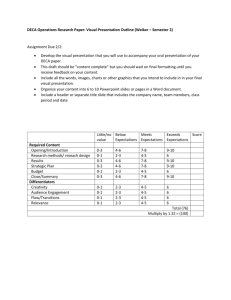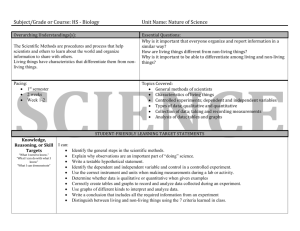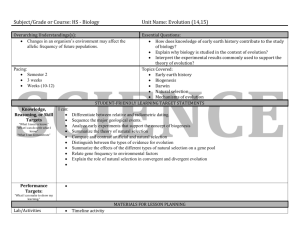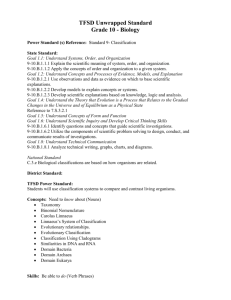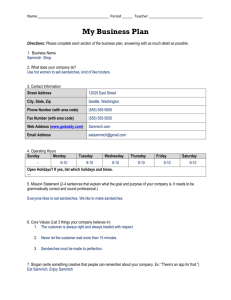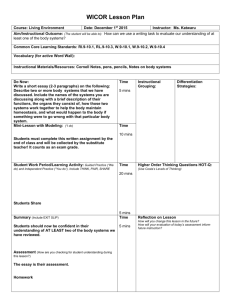Science and Technical Subjects 9-10
advertisement
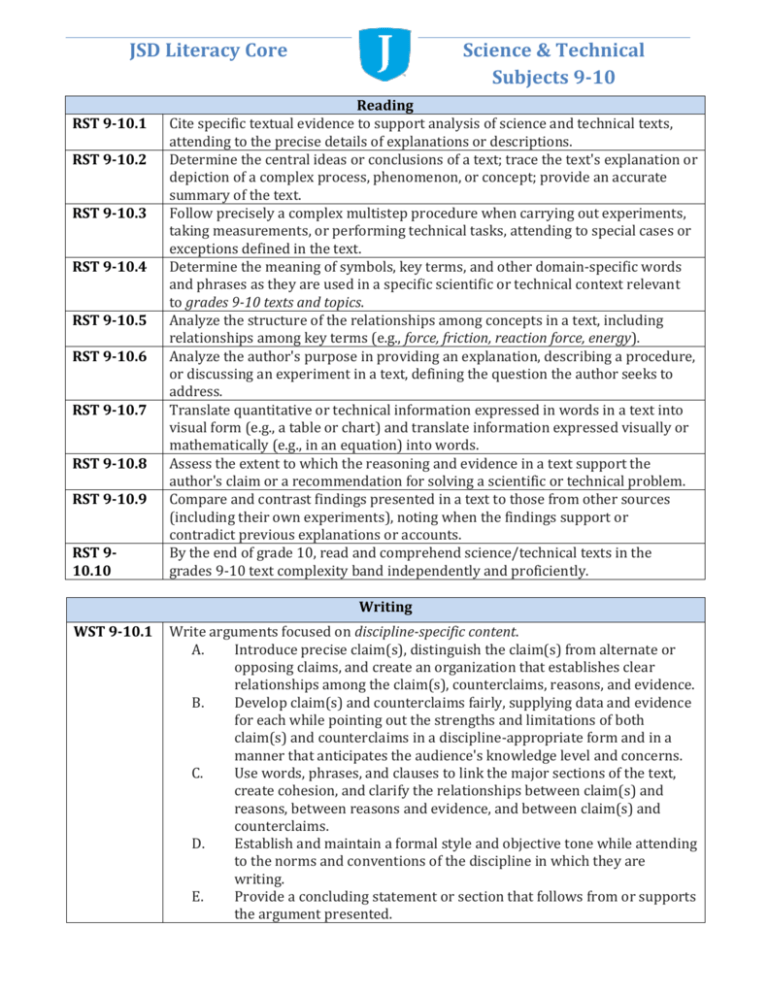
JSD Literacy Core RST 9-10.1 RST 9-10.2 RST 9-10.3 RST 9-10.4 RST 9-10.5 RST 9-10.6 RST 9-10.7 RST 9-10.8 RST 9-10.9 RST 910.10 Science & Technical Subjects 9-10 Reading Cite specific textual evidence to support analysis of science and technical texts, attending to the precise details of explanations or descriptions. Determine the central ideas or conclusions of a text; trace the text's explanation or depiction of a complex process, phenomenon, or concept; provide an accurate summary of the text. Follow precisely a complex multistep procedure when carrying out experiments, taking measurements, or performing technical tasks, attending to special cases or exceptions defined in the text. Determine the meaning of symbols, key terms, and other domain-specific words and phrases as they are used in a specific scientific or technical context relevant to grades 9-10 texts and topics. Analyze the structure of the relationships among concepts in a text, including relationships among key terms (e.g., force, friction, reaction force, energy). Analyze the author's purpose in providing an explanation, describing a procedure, or discussing an experiment in a text, defining the question the author seeks to address. Translate quantitative or technical information expressed in words in a text into visual form (e.g., a table or chart) and translate information expressed visually or mathematically (e.g., in an equation) into words. Assess the extent to which the reasoning and evidence in a text support the author's claim or a recommendation for solving a scientific or technical problem. Compare and contrast findings presented in a text to those from other sources (including their own experiments), noting when the findings support or contradict previous explanations or accounts. By the end of grade 10, read and comprehend science/technical texts in the grades 9-10 text complexity band independently and proficiently. Writing WST 9-10.1 Write arguments focused on discipline-specific content. A. Introduce precise claim(s), distinguish the claim(s) from alternate or opposing claims, and create an organization that establishes clear relationships among the claim(s), counterclaims, reasons, and evidence. B. Develop claim(s) and counterclaims fairly, supplying data and evidence for each while pointing out the strengths and limitations of both claim(s) and counterclaims in a discipline-appropriate form and in a manner that anticipates the audience's knowledge level and concerns. C. Use words, phrases, and clauses to link the major sections of the text, create cohesion, and clarify the relationships between claim(s) and reasons, between reasons and evidence, and between claim(s) and counterclaims. D. Establish and maintain a formal style and objective tone while attending to the norms and conventions of the discipline in which they are writing. E. Provide a concluding statement or section that follows from or supports the argument presented. JSD Literacy Core WST 9-10.2 WST 9-10.3 WST 9-10.4 WST 9-10.5 WST 9-10.6 WST 9-10.7 WST 9-10.8 Science & Technical Subjects 9-10 Write informative/explanatory texts, including the narration of historical events, scientific procedures/ experiments, or technical processes. A. Introduce a topic and organize ideas, concepts, and information to make important connections and distinctions; include formatting (e.g., headings), graphics (e.g., figures, tables), and multimedia when useful to aiding comprehension. B. Develop the topic with well-chosen, relevant, and sufficient facts, extended definitions, concrete details, quotations, or other information and examples appropriate to the audience's knowledge of the topic. C. Use varied transitions and sentence structures to link the major sections of the text, create cohesion, and clarify the relationships among ideas and concepts. D. Use precise language and domain-specific vocabulary to manage the complexity of the topic and convey a style appropriate to the discipline and context as well as to the expertise of likely readers. E. Establish and maintain a formal style and objective tone while attending to the norms and conventions of the discipline in which they are writing. F. Provide a concluding statement or section that follows from and supports the information or explanation presented (e.g., articulating implications or the significance of the topic). Not applicable as a separate requirement: Students’ narrative skills continue to grow in these grades. The Standards require that students be able to incorporate narrative elements effectively into arguments and informative/explanatory texts. In history/social studies, students must be able to incorporate narrative accounts into their analyses of individuals or events of historical import. In science and technical subjects, students must be able to write precise enough descriptions of the step-by-step procedures they use in their investigations or technical work that others can replicate them and (possibly) reach the same results. Produce clear and coherent writing in which the development, organization, and style are appropriate to task, purpose, and audience. Develop and strengthen writing as needed by planning, revising, editing, rewriting, or trying a new approach, focusing on addressing what is most significant for a specific purpose and audience. Use technology, including the Internet, to produce, publish, and update individual or shared writing products, taking advantage of technology's capacity to link to other information and to display information flexibly and dynamically. Conduct short as well as more sustained research projects to answer a question (including a self-generated question) or solve a problem; narrow or broaden the inquiry when appropriate; synthesize multiple sources on the subject, demonstrating understanding of the subject under investigation. Gather relevant information from multiple authoritative print and digital sources, using advanced searches effectively; assess the usefulness of each source in answering the research question; integrate information into the text selectively to maintain the flow of ideas, avoiding plagiarism and following a standard format for citation. JSD Literacy Core WH 9-10.9 Science & Technical Subjects 9-10 Draw evidence from informational texts to support analysis, reflection, and research. WH 9-10.10 Write routinely over extended time frames (time for reflection and revision) and shorter time frames (a single sitting or a day or two) for a range of disciplinespecific tasks, purposes, and audiences.

